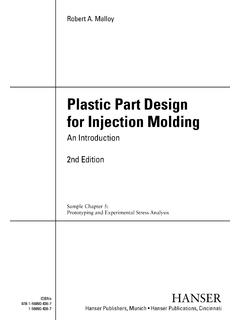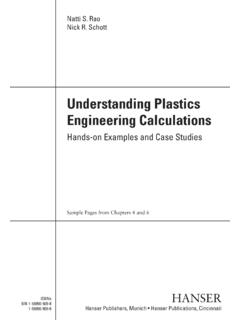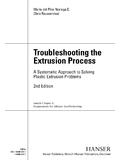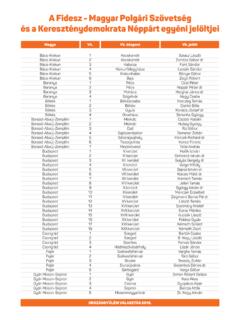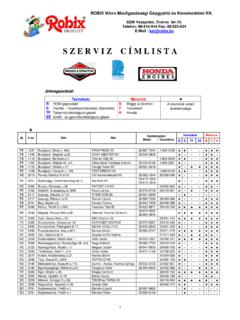Transcription of József Karger-Kocsis Stoyko Fakirov
1 Nano- and Micro-Mechanics of Polymer Blends and CompositesJ zsef Karger-KocsisStoyko FakirovISBNs978-1-56990-435-01-56990-435 -9 HANSERH anser Publishers, Munich Hanser Publications, CincinnatiSample Chapter 3:Nanoparticles/Polymer Composites:Fabrication and Mechanical PropertiesChapter 3 Nanoparticles/Polymer Composites:Fabrication and Mechanical PropertiesM. Q. Zhang, M. Z. Rong, W. H. IntroductionPolymeric nanocomposites have been an area of intense industrial and academicresearch for the past twenty years. No matter the measure articles, patents,or R&D funding efforts in this respect have been exponentially growingworldwide over the last ten years. It is believed that the tremendous interfacialarea helps to greatly influence the composite s properties. As compared to neatpolymers or micro-particulate filled polymer composites, polymer nanocom-posites exhibit markedly improved properties, including modulus, strength,impact performance, and heat resistance at low concentration of the inorganiccomponents (1~10 wt%) [1].
2 In this context, the nanocomposites are muchlighter in weight and easier to be respect to manufacturing of polymeric nanocomposites, direct incor-poration of inorganic nano-scale building blocks into polymers represents atypical way. Because of the strong tendency of nanoparticles to agglomerate,however, nano-size fillers are hard to be uniformly dispersed in polymers byconventional techniques. The most important issue for producing nanocompos-ites lies in surface modification of the nano-fillers. An ideal measure shouldbe able to increase the hydrophobicity of the fillers, enhance the interfacialadhesion via physical interaction or chemical bonding, and eliminate the loosestructure of filler present chapter reviews the recent achievements in the fabrication ofnanoparticles/polymer composites acquired in the authors laboratory, includingthe specific surface pre-treatment approaches and their applications. In addi-94M.
3 Q. Zhang et , effects of the treated nanoparticles on mechanical properties of thecomposites are general, the strategies of polymer nanocomposites manufacturing devel-oped by the authors fall into three categories. That is, (i) dispersion-oriented, (ii)dispersion and filler/matrix interaction-oriented, and (iii) dispersion, filler/fillerinteraction and filler/matrix interaction-oriented. The corresponding technicalroutes are based on one common nanoparticles surface modification method graft polymerization. Grafting macromolecules onto inorganic nanoparticleshas some advantages over the modification by low molecular surfactants orcoupling agents. The polymer-grafted particles can possess desired propertiesthrough a proper selection of the species of graft monomers and the graft condi-tions, so that the interfacial characteristics between the treated nanoparticlesand the matrix can be tailor-made when manufacturing , the fragile nanoparticle agglomerates become stronger because they turninto a nanocomposite microstructure comprising the nanoparticles, the graftedand the ungrafted (homopolymerized) polymer (Figure ).
4 A series of workshas been done in this field of growing interest for the purposes of improvingthe dispersibility of the nanoparticles in solvents and their compatibility inpolymers [2]. Mostly, the graft polymerization is conducted via two routes: (i)monomers are polymerized from active compounds (initiators or comonomers)Figure Schematic drawing of the structural change of nanoparticle agglomerates beforeand after graft polymerization treatmentNanoparticle agglomeratesbefore grafting treatmentNanoparticle agglomerateswith nanocomposite structureGraft polymerizationHomopolymerGraftedpolymerH omopolymercovalently attached to the inorganic surface (called grafting from ), and (ii)ready-made polymers with reactive end-groups react with the functional groupson the particles (called grafting to ). The latter benefits the control of themolecular weight of the grafting polymer. But, generally, the former approachhas advantage over the latter one as it is more difficult for polymers to penetrateinto the particulate agglomeration than monomers.
5 Besides, the grafting to technique would lead to a polymer coating on the particles, which might hinderthe attachment of other , surface grafting onto nanoparticles and compounding of dif-ferent ingredients to make nanocomposites can be completed by a one-step or95 Nanoparticles/Polymer Composites: Fabrication and ..a two-step process. In the following text, details of the fabrication and mechan-ical properties of nanocomposites are discussed with nano-SiO2/polypropylene(PP) as the model Dispersion-oriented manufacturing of Conventional two-step High energy irradiation induced graft coupled with meltcompoundingTo well disperse the nanoparticles in the polymer matrix, -ray irradiation graftpolymerization method was applied to modify SiO2 nanoparticles first, andthen the treated particles were mechanically mixed with PP as usual [3 5].Under the high energy radiation, the surfaces of the nanoparticles outside andinside the agglomerates are equally activated.
6 Therefore, the low molecularweight monomers are allowed to react with the activated sites of the nanopar-ticles throughout the agglomerates [6].Typical tensile stress-strain curves of neat PP and its filled version areshown in Figure , indicating that both a reinforcing and a toughening effectof the nanoparticles on the polymeric matrix was brought into play. That is,a structural weakness, which would have resulted from the agglomeratingbehavior of the nanoparticles, has been eliminated by the grafting macromolec-ular Typical tensile stress-strain curves of the neat PP matrix resin (MFI = g/10 min), and the one filled with SiO2-g-PS [3]. (SiO2-g-PS means polystyrene graftednano-SiO2)051015202501020304050 SiO2-g-PS/PP(SiO2 = vol%)PPStress (MPa)Strain (%)96M. Q. Zhang et SiO2/PP SiO2-g-PS/PP SiO2-g-PMMA/PPNormalized meanYoung's modulus (GPa)SiO2 (vol%)0123456273033363942 SiO2/PP SiO2-g-PS/PP SiO2-g-PMMA/PPTensile strength (MPa)SiO2 (vol%)By further examining the composition-dependent tensile properties of thematerials (Figure ), it can be seen that the incorporation of untreated nano-SiO2 lowers the tensile strength of PP in the lower loading region, but thenleads to a slight increase in strength when the particle fraction reaches vol%(Figure ).
7 When the nanocomposites are filled with polystyrene (PS) orpoly(methyl methacrylate) (PMMA) grafted SiO2, however, the situation isFigure Tensile properties of PP (MFI = g/10 min) based nanocomposites as a func-tion of SiO2 content: (a) tensile strength; (b) Young s modulus; (c) elongation to break; and(d) area under stress-strain curve [3]. (SiO2-g-PMMA means poly(methyl methacrylate)grafted nano-SiO2)(a)(b)97 Nanoparticles/Polymer Composites: Fabrication and .. SiO2/PP SiO2-g-PS/PP SiO2-g-PMMA/PPNormalized meanelongation to break (%)SiO2 (vol%)012345602468 SiO2/PP SiO2-g-PS/PP SiO2-g-PMMA/PPSiO2 (vol%)Area under stress-strain curve (MPa)Figure Continued(c)(d)quite different. There is a considerable rise in the strength of SiO2-g-PS/PPcomposites at a SiO2 content as low as vol%, then the strength remainsalmost unchanged with further addition of the filler. A similar behavior can beobserved in the case of SiO2-g-PMMA/PP, except that a slight drop in strengthoccurs when the filler content exceeds vol%.
8 Nevertheless, compared tothe untreated case, it can be stated here that mechanical loading seems to bemore effectively transferred from the matrix to the filler particles owing to theinterfacial bonding effect of the grafting polymers, which might be rooted in98M. Q. Zhang et TEM micrographs of PP (MFI = g/10 min) based nanocomposites filledwith (a) SiO2 as-received (content of SiO2 = vol%), (b) SiO2-g-PS (content of SiO2 = vol%), (c) SiO2-g-PS (content of SiO2 = vol%), (d) SiO2-g-PMMA (content ofSiO2 = vol%), and (e) SiO2-g-PMMA (content of SiO2 = vol%). Magnification =2 104 [3](a)(b)(c)(d)(e)an interdiffusion and entanglement between the molecules of the grafting poly-mers and the matrix. The decrease in tensile strength of SiO2-g-PMMA/PPabove vol% can be interpreted by a change in the dispersion status ofthe fillers. It is believed that a higher filler loading is detrimental to its uniformdispersion in the polymer matrix.
9 In fact, transmission electron microscopy(TEM) observation showed that the size of the dispersed phases increases withincreasing filler content in the nanocomposites (Figure ). It should be notedhere that the dispersed phases in the nanocomposites illustrated in Figure e are clearly smaller than the untreated SiO2 (Figure ), but they are stillmuch larger than the size of the primary nano-SiO2 particles (7 nm). Therefore,these dispersed phases are actually microcomposite agglomerates consistingof primary particles, grafting polymer, homopolymer, and a certain amountof is well-known that the interface adhesion markedly influences the mechan-ical behavior of particulate filled polymer composites [7 11]. The presentirradiation grafting pre-treatment provides possibilities for interfacial design, m99 Nanoparticles/Polymer Composites: Fabrication and .. , both surface characteristics of the nanoparticles and the particle agglomer-ates/matrix interface can be changed by using different grafting a result, the mechanical properties of the nanocomposites can be tailoredaccordingly.
10 Table gives the mechanical properties of nanocomposites filledwith SiO2 particles, grafted with various polymers, at a fixed SiO2 the monomers of the grafting polymers should have different miscibil-ities with PP, all the grafting polymers except poly(ethyl acrylate) (PEA)exhibit a reinforcement effect on the tensile strength of the results contribute to a further understanding of the modified nanopar-ticles and their role in the composites. That is, interdiffusion and entanglementof the grafting polymer segments with the polypropylene molecules, insteadof miscibility between the grafting polymer and the matrix, dominate theinterfacial interaction in the nanocomposites. This leads to the conclusion thata PP matrix with a higher molecular weight should even be entangled moreeffectively with the nanoparticle agglomerates, thus leading to a higher tensilestrength increment (comparing Figure with Table ). In fact, Kendalland Sherliker [12] studied the effect of the polymer molecular weight on colloidalsilica filled thermoplastics and observed a similar the moment, it can be concluded that the reinforcing effect of nanopar-ticles on the polymeric matrices can be realized as long as the particles aregrafted and a proper dispersion of the modified particles can be formed.




